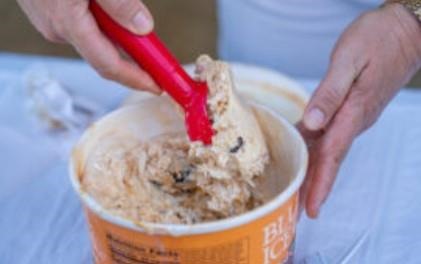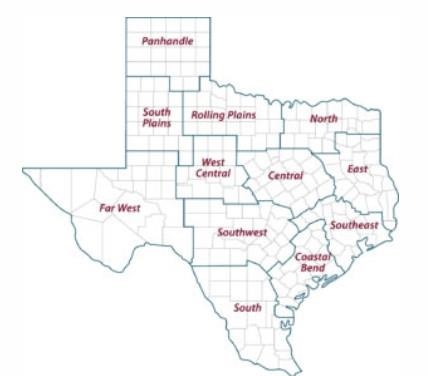Summer demand for ice cream and other dairy-based cold treats has historically contributed to higher milk prices for producers, but that has not been the case so far in 2023, according to Texas A&M AgriLife Extension Service experts.

Summertime treats like ice cream typically provide a price bump for dairy producers, but prices continue to stay relatively low. (Texas A&M AgriLife photo by Michael Miller)
Rising temperatures typically deliver the one-two price punch of higher demand and reduced production going into the dog days of summer, but dairies are currently producing a glut of milk. As a result, retail prices for an array of dairy-based products, including cheese and ice cream, remain high while producers are seeing low prices for raw milk.
Jennifer Spencer, Ph.D., AgriLife Extension dairy specialist, Stephenville, said milk prices were historically high for producers in 2022. Prices per hundredweight ranged between $23-$25 for most of the year and peaked at $25.87 in June and July last year.
However, prices per hundredweight have steadily declined this year and were $17.32 per hundredweight in the most recent U.S. Department of Agriculture report, she said. Hundredweight prices for producers were around $15 in 2020 and $17 by June 2021 as the pandemic interrupted typical demand, including cheese and butter for restaurants and carton milk for schools. They were around $19 per hundredweight before the pandemic.
Spencer said lower milk prices put pressure on a dairy operation’s ability to turn profits as other production costs, such as feed, fuel and labor continue to rise.
“Breakeven is different for every operation, but these prices may not be good for some producers,” she said. “They may have been optimistic in 2022 and expanded, but when prices drop $5-$6 per hundredweight, it makes it hard.”
Texas continues to add milk cows and production capacity as the number of dairy operations decline, Spencer said. There were 325 dairies in operation during 2021 and 319 dairies in 2022, while those operations added 20,000 cows to the statewide dairy herd.
Ice cream demand declining, production rising
David Anderson, Ph.D., AgriLife Extension economist, Bryan-College Station, said the lack of a summer price bump could be attributed to a few factors. U.S. dairy production is up, but it appears that overall milk demand is struggling a bit.
“The milk market is complex, and that makes it interesting,” he said. “There is a seasonality to the supply side and the demand side that keeps the market constantly moving.”
Spring conditions typically provide a flush of new grass and hay, silage and other forages, and ideal weather that pushes milk output by cows higher. Milk output slows as temperatures rise in the summer, while demand for ice cream increases.
In August, the built-in demand for carton milk at schools across the country pushes demand during the heat of summer. The holiday season delivers another level of demand as consumers increase their use of cheese, milk and other dairy products for baking.
In May, creameries produced 2.6% more hard ice cream than at that time last year. Retail prices for ice cream remained relatively high despite the low milk prices, he said. The Consumer Price Index showed May ice cream prices were $5.80 per half-gallon versus $5.35 per half-gallon at the same time last year.
Retail prices were showing signs of trending downward, he said. Cheddar cheese was $5.84 per pound, it’s lowest price since this time last year when a pound of cheese was $5.65.
Demand for the range of dairy-based products from protein powder, cheese and ice cream continues to push overall milk demand upward despite falling demand for specific products like liquid milk. It takes roughly 10 pounds of milk to make 1 pound of cheese. The cheese-making process produces whey, which is used in protein products.
Surprisingly, Anderson said ice cream consumption has steadily dipped over the last few decades. The U.S. consumed 18.2 pounds, a little over 4 gallons, of ice cream per capita in 1975 compared to 16.2 pounds in 2002, 13.2 pounds in 2012 and 12 pounds in 2021.
Cheese continues to show consistent demand growth, and processing plants to produce a range of hard and soft cheese products continue to expand to keep pace. Two new cheese-making facilities in Abilene and Lubbock are expected to be online this fall and in 2024, respectively.
Spencer said that processing capacity will help producers in the Panhandle, the region where 80% of the state’s dairy production is located. Some dairies in the No. 2 milk producing state – Wisconsin – were dumping milk because of low prices and processing capacity, Anderson said.
Dairy producers are thinning their milk herds in response to low prices and market factors to reduce costs and output, he said.
“Milk producers are responding to low prices and higher production and the market will have to adjust to what they are doing,” he said. “It’s summertime and I like ice cream, so I’m doing my part.”
AgriLife Extension district reporters compiled the following summaries:

CENTRAL
Temperatures were hot, but milder than the previous week. Soil moisture levels were very short to short. Little to no rain was causing pastures to brown. Pecan producers received some rainfall to help irrigation in orchards, but all agricultural commodities needed moisture to withstand the high heat and drought conditions. Dry conditions were favorable for harvesting corn and hay. Sorghum harvest should begin in the coming weeks. Fly, mosquito and tick numbers continued to increase on livestock. Rangeland and pasture conditions were poor to good, and livestock conditions were fair to good.
ROLLING PLAINS
Sporadic rain delivered showers to most areas. Some areas received enough rain to note improvements to livestock drinking tanks, improved hay conditions and the early cotton outlook. Other areas missed out on moisture and reported rapidly deteriorating conditions in pastures and hayfields. Insect pressure was also starting to be of concern. Sustained hot and dry conditions in the forecast were expected to test crops and livestock in the coming weeks.
COASTAL BEND
Some areas received rain that slowed harvest activity for a few days. Rain accumulations were minimal. Sorghum harvest was approximately 75% complete with about 5% of the acreage appearing to be a complete failure. Yields for sorghum were less than anticipated, however, yields in a few locations were average or above average. Corn harvest was underway in a few areas, many with better-than-average yields ranging from mid-80 to 140 bushels per acre. The weather was mostly favorable for harvest, but cloudy conditions and high humidity were also impacting corn drying times. Most fields continued to dry down. Grain moisture levels were between 14%-20% in fields that were harvested. Recent rain should help cotton and soybeans, but the heat was stressful for cotton and soybeans in the reproductive stages. Dry conditions this past month slowed down cotton growth. Cotton was shedding fruit, and yield losses were a concern. Later-planted cotton will be a failure in most cases and even some early cotton was expected to fail. Sunflowers appeared to be nearing harvest, and yield potential looked to be near or above average. Most rice has headed. Pasture conditions deteriorated drastically and continued to decline with hot dry weather. Livestock were doing well, and prices were holding strong. Livestock remained in good condition, and calves were still growing. Hay baling slowed due to dry weather.
SOUTH PLAINS
The district received 0.72 to a little over 1 inch of rainfall. Cotton progress varied throughout the area from just emerging to matchhead square stage. Cotton producers were scouting for flea hoppers and lygus and noting subsequent square drops. In corn and sorghum, a few mites were picked up but nothing at or above threshold. Pastures continued to improve. Cattle were grazing and were in good condition with minimal supplemental feeding. Rains reduced irrigation requirements in crops.
PANHANDLE
Most of the district received some rain with reports of 0.5-2.5 inches. Most counties reported adequate subsoil moisture, with some reporting adequate to surplus topsoil moisture. Wheat harvest was closer to completion with yields close to or below average. Corn looked great and was growing well due to recent rainfall. Cotton was lost to heavy rains in some areas, leading some producers to plant back with sorghum. Rangelands continued to improve, and some late-season grazing was expected. Crop, pasture and rangeland conditions were fair to excellent.
NORTH
Pastures and rangeland conditions were fair to good, while soil moisture ranged from short to adequate. Most counties received 2-6 inches of rainfall. The summer pasture growth was coming on strong. Ponds were in good shape from the rain, and vegetable gardens were producing well. Many corn and soybean producers were saying the rain should improve growing conditions. Livestock were in good shape. Webworms were showing up in the pecans.
FAR WEST
Daytime temperatures were in the 100s with overnight lows in the 70s. Isolated rain in trace amounts was reported in the low-lying areas, and widespread rainfall and cooler conditions were prevalent across much of the Davis Mountain area. Some areas received up to 2 inches of rainfall. This change in weather provided much-needed relief from the intense heat. Pasture conditions were spotty, but producers were hopeful recent rains marked the beginning of the summer monsoon season. Cotton began growing after relief from the heat stress. The earliest planted acres were holding on to some larger squares and will be blooming in the next week to 10 days. The latest planted cotton finally started squaring. Insect activity was non-existent. Corn was maturing very quickly due to hot dry winds, and most fields were entering dent stage already. Irrigated sorghum made decent progress. Melon harvest was picking up, but the first picking continued to be light. Subsoil and topsoil moisture conditions remained mostly short and some adequate. Rangeland conditions were steady, but more rain will be needed to improve conditions. Some pastures were completely bare. Brush remained a problem for ranchers. Livestock were in fair condition, but water and grazing were in short supply for many areas.
SOUTHEAST
Spotty rain was reported in a few areas, and temperatures dipped slightly. More rice was starting to head out. Most pastures were dry. Rangeland and pasture conditions ranged from very poor to excellent. The cattle market was holding steady with a slight dip for lower calf weights. Conditions were very dry with Increased fire concerns. Grasshopper numbers increased. Forages were not recovering well after cutting and/or grazing due to lack of moisture and excessive heat. Some crops were slowing down and showing heat stress.
SOUTHWEST
Scattered rainfall delivered spotty moisture with totals ranging from trace amounts to 6.5 inches, with some runoff reported. Lack of rain and high temperatures caused further deterioration of rangeland and pasture conditions, even though temperatures had cooled some. Forage was scarce, and hay cutting was greatly reduced to non-existent. Producers continued to sell stock due to drought. Livestock and wildlife were in fair to good condition. Supplemental feeding for cattle was necessary in drier areas. A return to higher temperatures was in the forecast. Gardens were performing well. Sorghum harvest was underway.
SOUTH
Topsoil and subsoil moisture levels improved in areas that received recent rainfall. Grain sorghum and corn continued to mature, and harvesting was underway in some areas. Cotton was setting bolls, but plants were struggling in the heat. Vegetable crops were starting to slow down. Strawberry harvest ended. Dryland cotton was flowering. Hay grazer fields that were not cut were burning up. Pivot irrigation was being utilized daily on crops. The peanut crop was in the pegging stage. Sesame crops were progressing well. Sunflower harvest was nearing completion. Citrus and sugarcane were receiving irrigation. Pasture and rangeland conditions improved in some areas but were generally poor due to lack of rain. Supplemental feeding continued but decreased overall. Ranchers were decreasing stocking rates. Fire concerns were growing in some areas. Cattle prices were steady.
Source : tamu.edu